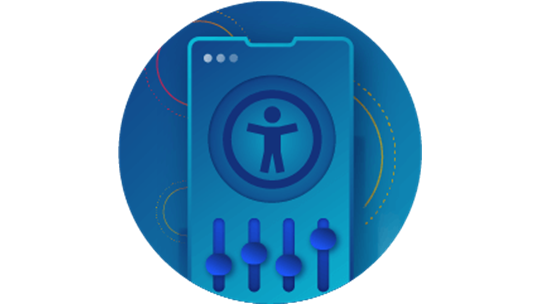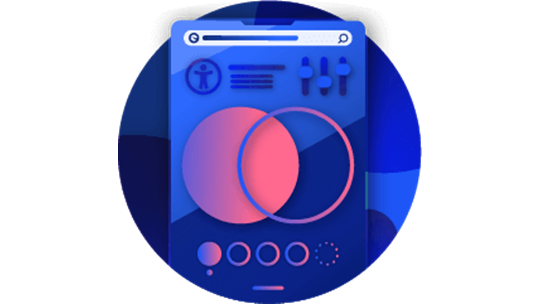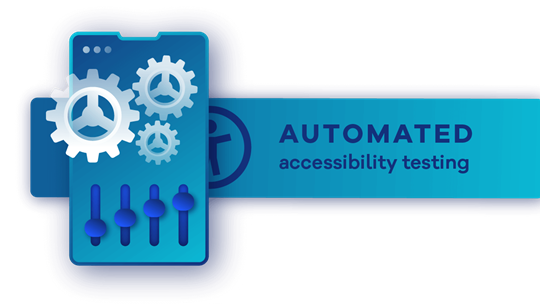Automated accessibility testing
Web accessibility has been a hot-button issue in online business since the days when the internet was more of a luxury than a necessity. As technology evolves and online interactions become the default for many aspects of day-to-day life, ensuring that your website is operable and accessible for users of all abilities is more crucial than ever.
Some countries around the world are adopting the World Wide Web Consortium’s Web Content Accessibility Guidelines (WCAG 2.0 and WCAG 2.1) and integrating parts of it into their official legislation.
You’re probably aware that there are a wide range of automated tools and services to help you test website accessibility. If you’ve been conscientious about keeping up with online accessibility it might be tempting to write them off as an unnecessary expenditure. However, even with meticulous attention, accessibility is simply too large a task to be moderated entirely by hand.
Can web accessibility testing be automated?
Yes. Automated accessibility testing tools enable you to audit thousands of documents, web pages, or even multiple websites simultaneously. Manual accessibility testing, on the other hand, requires an individual or team of accessibility experts to filter through a website’s content and code by hand to locate accessibility issues.
Besides saving your organization time and resources, a key feature of automated accessibility testing is that it provides accessibility compliance checks across your content on an ongoing basis. This means you can focus on preventing and fixing accessibility issues, rather than wasting valuable time trawling through your website(s) to locate them.
What does automated accessibility testing check for?
Whether you’re just starting to delve into accessibility or striving to keep up to date with the latest standards, software designed to identify areas that do not meet WCAG guidelines can save you a huge amount of time and labor.
Automated accessibility testing tools scan your website’s code to find common accessibility errors and flag potential issues. These softwares check your website against globally recognized accessibility standards, primarily the Web Content Accessibility Guidelines (WCAG).
Key issues automated accessibility software will search your website for include:
Page structure and navigation
- Detecting issues with menus or site navigability
- Suggesting improvements for users who rely on assistive technologies for navigation
- Checking for appropriate section headings
- Identifying page regions that need to be marked up for easy orientation
Readability and color contrast
- Checking font size and parsing to ensure optimal readability
- Identifying fonts with high character complexity or ambiguity
- Checking the spacing and weight of fonts
- Sufficient contrast between the font and background elements
Internal and external links
- Spotting uninformative link phrases such as “click here”
- Checking hover and focus elements of hyperlinks to ensure they are easily identifiable
- Detecting broken or empty links
Alt text and anchor texts
- Identifying images that don’t have alternative text
- Checking for alt text-based inputs for web elements like icons and emojis
- Checking alt text and anchor text is not repetitive or redundant
PDF accessibility
- Checking that images in PDFs have alt content
- Identifying PDF documents without bookmarks
- Ensuring correct tab and reading order in PDF files
- Checking for the use of table elements for markup in PDF documents
- Checking for interactive form controls in PDF files
Checking buttons
- Ensuring that buttons are big enough to be easily clicked on
- Checking for the presence of buttons to increase font size and spacing on the page
- Checking for the presence of buttons to reload the page
- Checking that all buttons are accurately labeled
Reviewing HTML and CSS
- Checking for issues in HTML parsing
- Ensuring that the page language is correctly identified in the HTML tag
- While not an entirely comprehensive list, these are some of the most common accessibility issues that automated accessibility testing helps you quickly identify on your website.

Why making sure web accessibility checks are automated is key to compliance
While manual accessibility testing has many benefits, it is often prohibitively time-consuming and requires a high level of accessibility knowledge – opening manual checks up to human error and potentially leading to non-compliance.
Some of the advantages of automated accessibility testing are:
- Can be done by someone without specialist accessibility knowledge.
- Often cheaper than hiring an in-house accessibility expert.
- Pinpoint recurring accessibility errors with ease.
- Check thousands of pages simultaneously, providing a comprehensive overview of your site’s accessibility status in minutes.
- Identify multiple errors caused by a single root issue.
- Task prioritization features are often included, so the most critical issues can be resolved first.
- Train and educates your organization on accessibility issues over time.
- Track your accessibility compliance and progress over time, with reporting functions available in many tools.
- Share easily-understandable accessibility results and tasks across departments, including website managers, designers, and content creators.
In practice, the best approach for many organizations will be a hybrid approach of automated and manual accessibility testing. Automated accessibility testing should be your first line of defense, helping you identify and resolve the majority of quick-fix issues before progressing to areas that require more analysis and human input with in-depth manual testing. However, your decision will also depend on the size and number of websites you manage, as well as how usable your content management system is.
How to automate accessibility testing with Siteimprove
Automated accessibility testing using a specialist automated accessibility solution is the best starting point for improving your website’s accessibility levels. While there are many free tools and checkers available to help you with this task, they tend to only locate basic accessibility issues, without providing explanations or recommendations for fixing them.
Siteimprove’s automated accessibility testing solution is different. It helps you pinpoint key accessibility issues on your website in minutes by measuring your site’s code and content against the latest WCAG standards.
But finding the issues is just half of the job, so Siteimprove makes digital accessibility even simpler to understand, implement, and maintain with a step-by-step process that guides your team towards compliance and implementing accessibility best practices. Key to this is using the tool’s insights to view your site’s accessibility errors by criticality, so it’s always clear which issues need to be tackled first. Because many website managers aren’t accessibility experts, Siteimprove Accessibility also provides clear explanations and actionable recommendations for understanding and correcting errors – including references to official WCAG remediation techniques.
The Siteimprove tool’s user interface has also been designed to make automated accessibility testing as simple as possible. It integrates easily with all leading content management systems, which means you can see issues highlighted directly on your webpage or within your code, so you jump straight in and fix them.
Finally, progress monitoring is a must-have for any organization that takes its digital accessibility seriously. That’s why Siteimprove Accessibility encourages you to track your progress towards WCAG conformance over time, with a single accessibility score for your whole website and a list of resolved issues, along with customizable accessibility goal setting.

Who can benefit from automated accessibility testing?
The short answer is – all types of organization! Both private sector and public institutions must ensure their websites are accessible to avoid legal repercussions and comply with key accessibility regulations in the US, such as the Americans with Disabilities Act (ADA). Use our ADA compliance website checker for more information.
High-profile organizations, from Amazon to Harvard University to Domino’s, have all faced discrimination lawsuits related to accessibility. Apart from the cost of these lawsuits, inaccessible websites lead to major reputational and brand damage, which is why it’s so important to regularly audit your site for accessibility blockers using automated accessibility testing tools.
Regular automated accessibility testing has other key benefits – including optimizing routine website maintenance. By identifying critical accessibility critical and smaller fixes that can be incorporated into existing workflows on an ongoing basis, accessibility improvements don’t become a bottleneck issue that slows down your digital team.
Accessible websites also tend to be rewarded with higher search engine rankings. For organizations planning large-scale website redesigns or website migrations, automated accessibility testing is especially important for maintaining their search engine rankings, catching unexpected or accidental accessibility errors that would otherwise quickly push them down the rankings, such as a failure to copy across image alt text, or an inaccessible new color palette.
What are the limitations of automated website accessibility testing?
Despite all of the advantages of running regularly scheduled automated accessibility tests, any healthy website should also include manual testing in its plans. There are areas where an automated tool cannot determine accessibility issues, but an actual human can.
These areas include making checks to ensure that all facets of a page can be accessed with keyboard-only navigation. It also involves detecting color contrast issues that make pages difficult for some users to read; checking HTML5 and Web Accessibility Issues in the Accessible Rich Internet Applications (WAI-ARIA) elements for coding best practices; and testing compatibility with leading screen readers.
The bottom line is that testing website accessibility regularly and thoroughly is a must in today’s online environment. With the advent of WCAG and along with accessibility regulations, an ever-growing number of seniors relying on the internet, a website experience that provides equal access to all users is important.
Whether your organization is new to the world of accessible content or looking to improve on your current approach, a well-considered combination of manual and automated accessibility testing will go a long way towards keeping your website usable for everyone who needs it.
Siteimprove’s free Accessibility Checker assists with manual accessibility testing by allowing you to check individual webpages for accessibility issues with quick visual feedback. Analysis is done directly within your Google Chrome browser, so you can get an immediate on-page overview of any accessibility issues, explanations of how they impact visitors to your site, and guidance for fixing them for any page – including password-protected areas.
